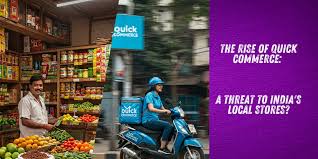🛍️ Introduction: The Dawn of Instant Retail
India’s retail sector is undergoing a radical transformation, with the rise of quick commerce—the promise of delivering groceries and essentials within 10 to 30 minutes. Platforms like Blinkit, Zepto, Swiggy Instamart, and BBNow are revolutionizing how urban India shops. But beneath this digital boom lies a growing concern: the potential erosion of the kirana store ecosystem—a traditional, deeply rooted network of small neighborhood retailers that have served Indian households for decades.
🚀 What is Quick Commerce?
Quick commerce, or Q-commerce, refers to ultra-fast delivery services that promise to bring essential items—groceries, toiletries, personal care products—straight to your doorstep within minutes of placing an order.
Driven by:
-
Urbanization
-
Changing consumer expectations
-
Widespread smartphone adoption
-
Investment in hyperlocal delivery infrastructure
Q-commerce is disrupting traditional shopping habits by offering speed, convenience, and deep discounts—three major factors influencing consumer behavior today.
📊 The Impact on Kirana Stores: Data Speaks
According to a Datum Intelligence study:
-
46% of consumers reported a decline in purchases from kirana stores
-
Kirana market share dropped from 95% in 2018 to 92.6% in 2023
-
It is projected to fall to 88.9% by 2028
More alarming:
-
82% of urban shoppers have shifted at least 25% of their purchases to quick commerce
-
5% have completely stopped shopping at kiranas
The All India Consumer Products Distributors Federation (AICPDF) estimates:
-
2,00,000 kirana stores shut down in the past year
-
Festive sales remained flat for kiranas, while online D2C brands grew by 250%
These numbers indicate that kirana stores—long considered the backbone of Indian retail—are rapidly losing ground to tech-savvy, investor-backed quick commerce platforms.
🧯 Why Kiranas Are Struggling
-
Technology Gap: Kiranas often lack access to the digital tools and platforms that quick commerce companies leverage for inventory, logistics, and customer experience.
-
Deep Discounting: Q-commerce platforms are funded by venture capital and can afford to offer prices that small retailers simply can’t match.
-
Changing Consumer Priorities: Today’s consumers value speed and convenience over loyalty. This is particularly true in metropolitan cities.
-
High Operating Costs: Rising rents, fuel costs, and supply chain challenges make it harder for small retailers to stay profitable.
-
Inventory Issues: Kiranas cater to localized demand but struggle with slow inventory turnover as footfall drops.
🏬 Kirana Stores: Still a Crucial Part of India’s Retail Fabric
Despite the challenges, India’s kirana ecosystem remains massive:
-
Over 13 million kirana stores
-
Account for ~80% of India’s grocery sales
-
Provide employment and livelihood to millions
“The kirana store isn’t just a shop. It’s a part of the local economy, community trust, and consumer behavior. Quick commerce may be booming, but we must protect this traditional model.”
💡 The Path to Coexistence: What Needs to Happen
For kiranas to survive and thrive alongside quick commerce, adaptation and support are key:
1. Digital Integration
-
Platforms like Udaan, JioMart, and BharatPe are already helping kiranas adopt POS systems, inventory management tools, and online ordering.
2. Government Support
-
Regulatory interventions to control predatory pricing and deep discounting
-
Financial incentives and subsidies for digital upskilling and modernization
3. FMCG Support
-
FMCG companies are now customizing products (in terms of pack size and pricing) to help kiranas compete with modern trade and quick commerce formats.
4. Collaborative Ecosystem
-
Hybrid models where kirana stores become fulfillment hubs for Q-commerce platforms—leveraging their local presence with tech-enabled logistics.
📈 Quick Commerce: The Growth Is Relentless
-
India’s quick commerce market is expected to reach $6 billion by 2025
-
The segment grew 230% between 2021 and 2023
-
40% of online grocery sales now come via Q-commerce
-
Platforms like Flipkart, Amazon, Nykaa, and FirstCry are joining the race with ultra-fast delivery models
Flipkart Minutes, Myntra M-Now, and Amazon’s Tez are further pushing the Q-commerce envelope, aiming for not just groceries but also fashion and beauty essentials.
🔮 The Future: Disruption or Transformation?
While kirana stores face unprecedented disruption, this is also a moment of transformation. With the right policies, partnerships, and technology interventions, kiranas can evolve into digitally enabled micro-retailers. They can serve both walk-in customers and online orders, offer credit, and build stronger consumer relationships than faceless apps ever could.
But without intervention, the unchecked rise of quick commerce risks dismantling a retail culture that has thrived in India for generations.
✅ Conclusion: The Need for a Balanced Retail Ecosystem
Quick commerce is here to stay. It caters to the fast-paced, urban lifestyle of today’s digital consumer. However, the survival of kirana stores is essential—not just for economic diversity but for social resilience and community identity.
The road ahead requires:
-
Collaborative innovation
-
Ethical business practices
-
Regulatory fairness
-
Empowerment of traditional retailers
Only then can India maintain a balanced, inclusive, and future-ready retail ecosystem.

